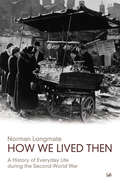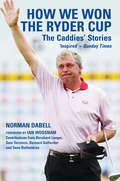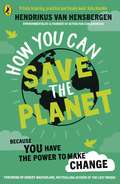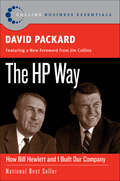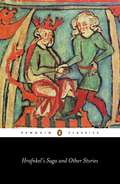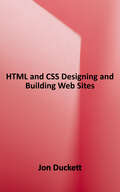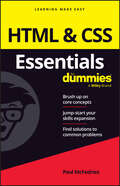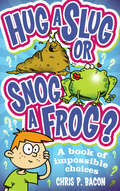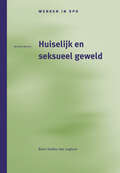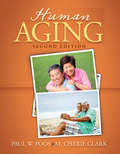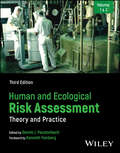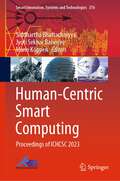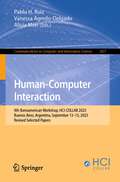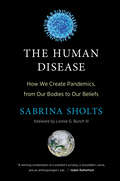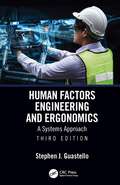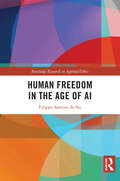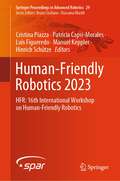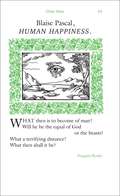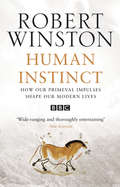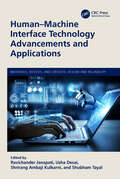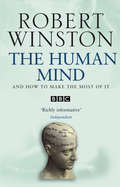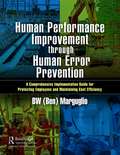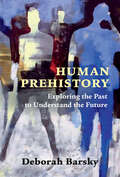- Table View
- List View
How We Lived Then: History of Everyday Life During the Second World War, A
by Norman LongmateAlthough nearly 90% of the population of Great Britain remained civilians throughout the war, or for a large part of it, their story has so far largely gone untold. In contrast with the thousands of books on military operations, barely any have concerned themselves with the individual's experience. The problems of the ordinary family are barely ever mentioned - food rationing, clothes rationing, the black-out and air raids get little space, and everyday shortages almost none at all. This book is an attempt to redress the balance; to tell the civilian's story largely through their own recollections and in their own words.
How We Won the Ryder Cup: The Caddies' Stories
by Norman DabellThe Ryder Cup battle between Europe and the USA is one of the biggest events in the golfing calendar and in 2006, the former underdogs showed they are now the dominant force in the biennial matches. It was another marvellous example of teamwork, and the caddies have played no small part in Europe overcoming the odds. The players hit the shots; their trusty caddies share the hopes, the glory and, occasionally, the misery.What was it like being beside Sam Torrance when he holed the winning putt and shed his tears on that historic moment at The Belfry in 1985? Fast forward to 2006 and a highly emotional appearance by Darren Clarke. What was it like being by his side? What was the story behind Colin Montgomerie's right-hand-man returning to his bag to help lay to rest the ghost of 1999? How do you cope when Seve Ballesteros is in full cry against the 'old enemy', especially when you are an American yourself? In 1991, a spike mark cost Europe the tournament, but what really happened behind the ropes? Who knew his man had had a vision he would beat Tiger Woods in 1997 - and saw it come true? What was it like witnessing those awful scenes at Brookline up close and personal in 1999? Who knew exactly which line to take when Paul McGinley sank his memorable winning putt in 2002?How We Won the Ryder Cup covers all the drama that has unfolded in the competition over the years and includes the action from the 2006 tournament at The K Club, County Kildare in Ireland, which saw Europe storm to a third successive victory.
How You Can Save the Planet
by Hendrikus van Hensbergen*Foreword by Robert Macfarlane, bestselling author of The Lost Words.*If you're worried about climate change, this book is an essential and reassuring read.We often feel like we don't have the power to make real change.But our small changes can add up to something BIG. Packed with reassuring step by step actions and easy to follow DIY activities, How You Can Save The Planet is the perfect gift for young activists who want to make a difference.With simple explanations, practical tips and stories from children across the world, this guide is ideal for young people who are worried about climate change and want to help our planet!Crafted by Hendrikus van Hensbergen, whose work is featured on BBC Bitesize[JP2] , this inspiring read is perfect for children at KS2. 'Every young person in the country should be given this book' Sir Tim Smit, Founder of The Eden Project'It's enlightening, inspiring and empowering' Kate Humble, TV presenter'Wonderfully informative, fun and practical [. . .] A great source of inspiration' The Rich Brothers, TV presenters
The HP Way: How Bill Hewlett and I Built Our Company (Collins Business Essentials)
by David PackardIn the fall of 1930, David Packard left his hometown of Pueblo, Colorado, to enroll at Stanford University, where he befriended another freshman, Bill Hewlett. After graduation, Hewlett and Packard decided to throw their lots in together. They tossed a coin to decide whose name should go first on the notice of incorporation, then cast about in search of products to sell.Today, the one-car garage in Palo Alto that housed their first workshop is a California historic landmark: the birthplace of Silicon Valley. And Hewlett-Packard has produced thousands of innovative products for millions of customers throughout the world. Their little company employs 98,400 people and boasts constantly increasing sales that reached $25 billion in 1994.While there are many successful companies, there is only one Hewlett-Packard, because from the very beginning, Hewlett and Packard had a way of doing things that was contrary to the prevailing management strategies. In defining the objectives for their company, Packard and Hewlett wanted more than profits, revenue growth and a constant stream of new, happy customers.Hewlett-Packard's success owes a great deal to many factors, including openness to change, an unrelenting will to win, the virtue of sustained hard work and a company-wide commitment to community involvement. As a result, HP now is universally acclaimed as the world's most admired technology company; its wildly successful approach to business has been immortalized as The HP Way.In this book, David Packard tells the simple yet extraordinary story of his life's work and of the truly exceptional company that he and Bill Hewlett started in a garage 55 years ago.
Hrafnkel's Saga and Other Icelandic Stories
by AnonymousWritten around the thirteenth century AD by Icelandic monks, the seven tales collected here offer a combination of pagan elements tightly woven into the pattern of Christian ethics. They take as their subjects figures who are heroic, but do not fit into the mould of traditional heroes. Some stories concern characters in Iceland - among them Hrafknel's Saga, in which a poor man's son is murdered by his powerful neighbour, and Thorstein the Staff-Struck, which describes an ageing warrior's struggle to settle into a peaceful rural community. Others focus on the adventures of Icelanders abroad, including the compelling Audun's Story, which depicts a farmhand's pilgrimage to Rome. These fascinating tales deal with powerful human emotions, suffering and dignity at a time of profound transition, when traditional ideals were gradually yielding to a more peaceful pastoral lifestyle.
HTML & CSS Design and Build Websites
by Jon DuckettA two-book set for web designers and front-end developers This two-book set combines the titles HTML & CSS: Designing and Building Web Sites and JavaScript & jQuery: Interactive Front-End Development. Together these two books form an ideal platform for anyone who wants to master HTML and CSS before stepping up to JavaScript and jQuery. HTML & CSS covers structure, text, links, images, tables, forms, useful options, adding style with CSS, fonts, colors, thinking in boxes, styling lists and tables, layouts, grids, and even SEO, Google analytics, FTP, and HTML5. JavaScript & jQuery offers an excellent combined introduction to these two technologies using a clear and simple visual approach using diagrams, infographics, and photographs. - A handy two-book set that uniquely combines related technologies - Highly visual format and accessible language makes these books highly effective learning tools - Perfect for beginning web designers and front-end developers
HTML & CSS Essentials For Dummies
by Paul McFedriesThe easy way to brush up on your HTML & CSS programming skills HTML & CSS Essentials For Dummies is your quick and handy reference to all the core concepts of HTML & CSS—the must-know markup and style languages that make the internet go. This no-nonsense book gets right to the point, eliminating review material, wordy explanations, and fluff. Understand all the fundamentals of HTML and CSS, quickly. Perfect for a brush-up on the basics or as an everyday desk reference on the job, this is the reliable little book you can always turn to for answers. Get simple explanations of the basic concepts of coding with HTML & CSS Review what you've already learned or pick up essential new skills Create attractive and functional front ends for websites of all kinds Keep this concise reference book handy for jogging your memory as you work This book is clear and direct, focusing on the key topics you need to know about defining a website's user interface. Great for supplementing classroom learning, reviewing for a certification, or staying knowledgeable on the job.
Hug a Slug or Snog a Frog?: A book of impossible choices
by Chris P BaconWhat would YOU rather do - hug a slug OR snog a frog? Have hair made of soggy spaghetti OR a nose made of plasticine? Be best friends with the Incredible Hulk OR with Batman? This brilliantly funny and totally addictive collection of impossible choices will keep you entertained for hours!
A Hug in a Book: Everyday Self-Care and Comforting Rituals
by My Self-Love SupplyWhat if all it took to improve each day was 5 minutes? From the Instagram page @MySelfLoveSupply comes A Hug in Your Book, a pocket-sized comfort book that will transform your everyday life through tiny habit changes. Filled with 5-minute, 15-minute and 30-minute self-care routines tailored to your needs, it is a book full of self-kindness tips, quotes, reminders and routines for happier days.
Hugs: 365 Devotions to Inspire Your Day
by Howard BooksInspirational hugs of appreciation for the love that grandmothers share -- every day of the year.
Huiselijk en seksueel geweld (Werken in SPH)
by B. Fontaine Marijke van Bommel M.J. van Deutekom M. Magnee A.J. RavelliWerken in SPH Huiselijk en seksueel geweld
Human Aging
by Paul W. Foos M. Cherie ClarkThis text offers a readable and friendly presentation of the important methods, findings, and theories of human aging, while actively involving the reader in meaningful exercises and critical thinking. Students are repeatedly challenged to apply information in the text to the older adults in their own lives. Specifically, suggestions for enhancing the lives of their older relatives are offered and encouraged. These include guidelines for discussions they might have regarding social, emotional, and environmental changes as well encouraging intellectual and social interaction. In this Edition: Emphasis on the science of the study of aging and why questions in aging are difficult to answer, how social scientists attempt to handle such difficulties, and the successes and failures social scientists have had thus far in answering those questions. The text also demonstrates how current research findings are now being applied in the real world and/or how they might be applied in the future. Cross-cultural comparisons and ethnic group comparisons are included wherever possible. Each chapter begins with "Senior View," which introduces students to a real person and gives them a chance to hear what older adults think and say about important issues related to the chapter and a chance to compare those opinions to the research findings. Each chapter ends with "Making Choices," emphasizing the important behavioral, emotional, and social choices that students can make now to prolong a healthy, happy life. "Chapter Projects" offer the opportunity for active learning, as students investigate for themselves an issue related to the chapter. Instructors can expand these projects for students who want to learn more, or for independent study. "Focus on Aging" boxes compliment the material in the text, providing additional insight and examples, and encouraging critical thinking. Every chapter includes discussion questions, study questions, chapter exercises, and related online resources.
Human and Ecological Risk Assessment: Theory and Practice, Set
by Dennis J. PaustenbachUnderstand the fundamentals of human risk assessment with this introduction and reference Human risk assessments are a precondition for virtually all industrial action or environmental regulation, all the more essential in a world where chemical and environmental hazards are becoming more abundant. These documents catalog potential environmental, toxicological, ecological, or other harms resulting from a particular hazard, from chemical spills to construction projects to dangerous workplaces. They turn on a number of variables, of which the most significant is the degree of human exposure to the hazardous agent or process. Human and Ecological Risk Assessment combines the virtues of a textbook and reference work to introduce and analyze these vital documents. Beginning with the foundational theory of human health risk assessment, it then supplies case studies and detailed analysis illustrating the practice of producing risk assessment documents. Fully updated and authored by leading authorities in the field, the result is an indispensable work. Readers of the second edition of Human and Ecological Risk Assessment will also find: Over 40 entirely new case studies reflecting the latest in risk assessment practice Detailed discussion of hazards including air emissions, contaminated food and soil, hazardous waste sites, and many more Case studies from multiple countries to reflect diverse international standards Human and Ecological Risk Assessment is ideal for professionals and advanced graduate students in toxicology, industrial hygiene, occupational medicine, environmental science, and all related subjects.
Human-Centric Smart Computing: Proceedings of ICHCSC 2023 (Smart Innovation, Systems and Technologies #376)
by Siddhartha Bhattacharyya Jyoti Sekhar Banerjee Mario KöppenThis book includes high-quality research papers presented at the Second International Conference on Human-Centric Smart Computing (ICHCSC 2023), organized by the University of Engineering and Management, Jaipur, India, on 5–6 July 2023 in New Delhi, India. The topics covered in the book are human-centric computing, hyper connectivity, and data science. The book presents innovative work by leading academics, researchers, and experts from industry.
Human-Computer Interaction: 9th Iberoamerican Workshop, HCI-COLLAB 2023, Buenos Aires, Argentina, September 13–15, 2023, Revised Selected Papers (Communications in Computer and Information Science #1877)
by Pablo H. Ruiz Vanessa Agredo-Delgado Alicia MonThis book constitutes the referred proceedings of the 9th Iberoamerican Workshop on Human-Computer Interaction, HCI-COLLAB 2023, held in Buenos Aires, Argentina, during September 13–15, 2023. The 23 full papers presented in this book were carefully reviewed and selected from 84 submissions. They cover a variety of topics related to HCI such as: Emotional Interfaces, Usability, Video Games and Gamification, Computational Thinking, Internet of Things (IoT), Software Engineering, ICT in Education, Augmented and Mixed Virtual Reality for Education, Emotional Interfaces, Adaptive Instructional Systems, Accessibility, Artificial Intelligence in HCI, Industry 4. 0 and HCI, Infotainment Systems, Intelligent Systems, Collaborative Work and Learning, Cognition, and Interaction, among others.
The Human Disease: How We Create Pandemics, from Our Bodies to Our Beliefs
by Sabrina SholtsHow the very fact of being human makes us vulnerable to pandemics—and gives us the power to save ourselves.The COVID-19 pandemic won&’t be our last—because what makes us vulnerable to pandemics also makes us human. That is the uncomfortable but all-too-timely message of The Human Disease, which travels through history and around the globe to examine how and why pandemics are an inescapable threat of our own making. Drawing on dozens of disciplines—from medicine, epidemiology, and microbiology to anthropology, sociology, ecology, and neuroscience—as well as a unique expertise in public education about pandemic risks, biological anthropologist Sabrina Sholts identifies the human traits and tendencies that double as pandemic liabilities, from the anatomy that defines us to the misperceptions that divide us.Weaving together a wealth of personal experiences, scientific findings, and historical stories, Sholts brings dramatic and much-needed clarity to one of the most profound challenges we face as a species. Though the COVID-19 pandemic looms large in Sholts&’s account, it is, in fact, just one of the many infectious disease events explored in The Human Disease. With its expansive, evolutionary perspective, the book explains how humanity will continue to face new pandemics because humans cause them, by the ways that we are and the things that we do. By recognizing our risks, Sholts suggests, we can take actions to reduce them. When the next pandemic happens, and how bad it becomes, are largely within our highly capable human hands—and will be determined by what we do with our extraordinary human brains.
Human Factors Engineering and Ergonomics: A Systems Approach
by Stephen J. GuastelloThis textbook comprehensively covers the basic principles and most recent advances regarding visual displays, auditory and tactile displays and controls; psychophysics; cognitive processes; human-computer interaction, artificial intelligence and artificial life; stress and human performance; occupational accidents and prevention; human group dynamics and complex systems; and anthropometry, workspace and environmental design. The systems perspective emphasizes nonlinear dynamics for system performance changes and emergent behaviours of complex person-machine systems.This book- • Surveys principles of conventional and computer-based machine interaction. • Assesses the relative effectiveness of accident analysis and prevention strategies. • Highlights nonlinear dynamics for system performance changes. • Examines artificial intelligence and complex systems. • Investigates sources of cognitive workload and fatigue. The textbook will be a valuable resource for advanced undergraduates and graduate students in diverse fields including ergonomics, human factors, cognitive science, computer science, operations management, and psychology. The textbook brings together core principles of person-machine interaction, accident analysis and prevention strategies, risk analysis and resilience, artificial intelligence, group dynamics, and nonlinear dynamics for an enhanced understanding of complex person-machine systems.
Human Freedom in the Age of AI (Routledge Research in Applied Ethics)
by Filippo Santoni de SioThis book claims that artificial intelligence (AI) may affect our freedom at work, in our daily life, and in the political sphere. The author provides a philosophical framework to help make sense of and govern the ethical and political impact of AI in these domains. AI presents great opportunities and risks, raising the question of how to reap its potential benefits without endangering basic human and societal values. The author identifies three major risks for human freedom. First, AI offers employers new forms of control of the workforce, opening the door to new forms of domination and exploitation. Second, it may reduce our capacity to remain in control of and responsible for our decisions and actions, thereby affecting our free will and moral responsibility. Third, it may increase the power of governments and tech companies to steer the political debate, thereby affecting the possibility of a free and inclusive political participation. The author claims that it is still possible to promote human freedom in our interactions with AI. This requires designing AI systems that help promote workers’ freedom, strengthen human control and responsibility, and foster a free, active, and inclusive democratic participation.Human Freedom in the Age of AI will be of interest to scholars and graduate students working on the ethics of technology, philosophy of technology, political philosophy, design, and artificial intelligence.
Human-Friendly Robotics 2023: HFR: 16th International Workshop on Human-Friendly Robotics (Springer Proceedings in Advanced Robotics #29)
by Cristina Piazza Patricia Capsi-Morales Luis Figueredo Manuel Keppler Hinrich SchützeComprising sixteen independent chapters, this book covers recent advancements and emerging pathways within human-friendly robotics on physical and cognitive levels. Each chapter presents a novel work presented at HFR 2023 by researchers from various robotic domains, where new theories, methodologies, technologies, challenges, and empirical and experimental studies are discussed. The multidisciplinary nature of the authors enriches the compilation with varied viewpoints, making it an excellent resource for academics, researchers, and industry professionals to get acquainted with the state of the art on human-robot interaction.
Human Happiness (Penguin Great Ideas)
by Blaise PascalCreated by the seventeenth-century philosopher and mathematician Pascal, the essays contained in Human Happiness are a curiously optimistic look at whether humans can ever find satisfaction and real joy in life – or whether a belief in God is a wise gamble at best. Throughout history, some books have changed the world. They have transformed the way we see ourselves – and each other. They have inspired debate, dissent, war and revolution. They have enlightened, outraged, provoked and comforted. They have enriched lives – and destroyed them. Now Penguin brings you the works of the great thinkers, pioneers, radicals and visionaries whose ideas shook civilization and helped make us who we are.
Human Instinct
by Professor Lord Robert WinstonFrom caveman to modern man ...Few people doubt that humans are descended from the apes; fewer still consider, let alone accept, the psychological implications. But in truth, man not only looks, moves and breathes like an ape, he also thinks like one. Sexual drive, survival, competition, aggression - all of our impulses are driven by our human instincts. They explain why a happily married man will fantasize about the pretty, slim, young woman sitting across from him in the tube and why thousands of people spend their week entirely focused on whether their team will win their next crucial match. But how well do our instincts equip us for the twenty-first century? Do they help or hinder us as we deal with large anonymous cities, stressful careers, relationships and the battle of the sexes? In this fascinating book, Robert Winston takes us on a journey deep into the human mind. Along the way he takes a very personal look at the relationship between science and religion and explores those very instincts that make us human.
Human-Machine Interface Technology Advancements and Applications (Materials, Devices, and Circuits)
by Ravichander Janapati, Usha Desai, Shrirang Ambaji Kulkarni, and Shubham TayalHuman–Machine Interface Technology Advancements and Applications focuses on analysis, design, and evaluation perspectives in HMI technological breakthroughs and applications. It covers a wide range of ideas, methodologies, approaches, and instruments to give the reader a thorough understanding of the field's current academic and industry practice and debate. Physical, cognitive, social, and emotional factors are all considered in the work, which is exemplified by key application fields such as aerospace, automobile, medicine, and defense. This book covers AI and machine learning methodologies as well as biological signals and HMI applications. Nanotechnology, user interface design, and interactive systems are also featured. The MATLAB approach to signal processing applications is also included.This book discusses advances in the field of human–machine interfaces and provides practical knowledge in biomedical signal processing, AI, and machine learning. It discusses augmented reality/virtual reality-based HMI applications. It examines advances in nanotechnology, user interface design, and interactive systems.This book is intended to serve as a research guide that will both inform readers about the fundamentals of HMI from academic and industrial perspectives and provide a glimpse into how human-centered designers, such as engineers and human factors specialists, will attempt to design and develop human–machine systems in the future.
The Human Mind
by Professor Lord Robert WinstonIt is the most complex and mysterious object in the universe. Covered by a dull grey membrane, it resembles a gigantic, convoluted fungus. Its inscrutability has captivated scientists, philosophers and artists for centuries. It is, of course, the human brain.With the help of science we can now begin to understand the extraordinary complexity of the brain's circuits: we can see which nerve cells generate electricity as we fall in love, tell a lie or dream of a lottery win. And inside the 100 billion cells of this rubbery network is something remarkable: you. In this entertaining and accessible book, Robert Winston takes us deep into the workings of the human mind and shows how our emotions and personality are the result of genes and environment. He explains how memories are formed and lost, how the ever-changing brain is responsible for toddler tantrums and teenage angst, plus he reveals the truth behind extra-sensory perception, déjà vu and out-of-body experiences. He also tells us how to boost our intelligence, how to tap into creative powers we never knew we had, how to break old habits and keep our brain fit and active as we enter old age.The human mind is all we have to help us to understand it. Paradoxically, it is possible that science may never quite explain everything about this extraordinary mechanism that makes each of us unique.
Human Performance Improvement through Human Error Prevention: A Comprehensive Implementation Guide for Protecting Employees and Maintaining Cost Efficiency
by BW (Ben) MarguglioThis book is a simulation of a live course on human performance improvement/human error prevention (HPI/HEP) created by the preeminent authority on HPI/HEP. It presents the greatest breadth of scope and specificity on this topic. This book comprises a focused, challenging human error prevention training course designed to improve understanding of error causation. It will dramatically reduce human error and repeat deviations, and it digs below the surface of issues and looks to fix the real causes of human error and mistakes. In addition, this book presents a complete seminar from the thought leader acclaimed by hundreds of clients, and includes unique principles, practices, models, and templates. Information is comprehensive and can be directly implemented. The principles and practices of human error prevention are universally applicable regardless of the type of industrial, commercial, or governmental enterprise, and regardless of the type of function performed within the enterprise. The application of the information in this book will significantly contribute to improved productivity, safety, and quality. After fully using this book, you will understand: Human error prevention/reduction terminology and definitions. The relationships among culture, beliefs, values, attitudes, behavior, results, and performance. The roles of leadership in establishing and maintaining a quality/safety-conscious work environment. The one fundamental precept explaining the importance of human error prevention/reduction. The two most critical elements of human error prevention/reduction. The three levels of barriers to human error. The four types of things in which the barriers may exist at each barrier level. The five stages of human error. The six "M"s that can emit or receive hazards activated by human error. The seven universally applicable human error causal factors. The Rule of 8 by which to prevent human error and mitigate its effects. Techniques for making barriers effective and the spectrum of barrier effectiveness. The relationship of human error prevention/reduction to the total quality/safety function. Error-inducing conditions (error traps) and behaviors for counteracting these conditions. Non-conservative and conservative thought processes and behaviors in decision-making. Coaching for preventing the recurrence of human error. Root cause analysis techniques for identifying human error causal factors. The nine types of corrective action. Human error measurement. Strategies for a human error prevention/reduction initiative. How to design, implement, and manage a human error prevention/reduction initiative.
Human Prehistory: Exploring the Past to Understand the Future
by Deborah BarskyThis book provides a concise overview of human prehistory. It shows how an understanding of the distant past offers new perspectives on present-day challenges facing our species - and how we can build a sustainable future for all life on planet Earth. Deborah Barsky tells a fascinating story of the long-term evolution of human culture and provides up-to-date examples from the archaeological record to illustrate the different phases of human history. Barsky also presents a refreshing and original analysis about issues plaguing modern globalized society, such as racism, institutionalized religion, the digital revolution, human migrations, terrorism, and war. Written in an accessible and engaging style, Human Prehistory is aimed at an introductory-level audience. Students will acquire a comprehensive understanding of the interdisciplinary, scientific study of human prehistory, as well as the theoretical interpretations of human evolutionary processes that are used in contemporary archaeological practice. Definitions, tables, and illustrations accompany the text.
